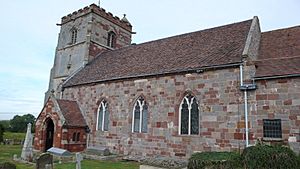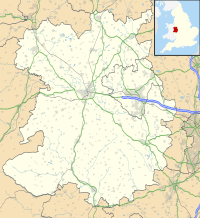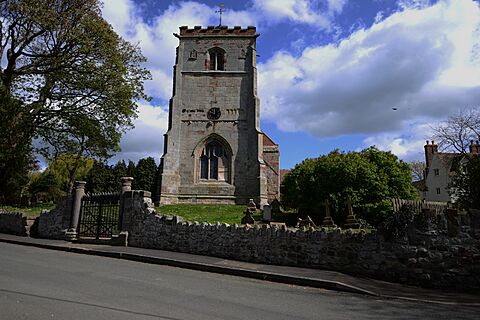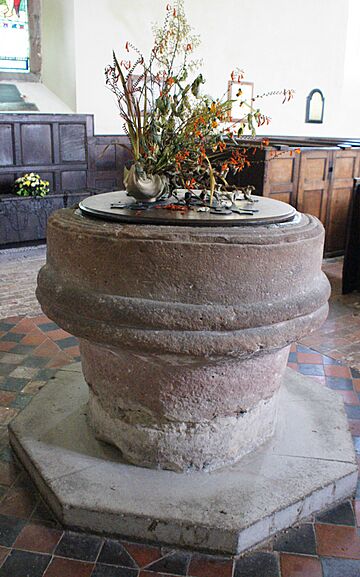St Andrew's Church, Wroxeter facts for kids
Quick facts for kids St Andrew's Church, Wroxeter |
|
|---|---|

St Andrew's Church, Wroxeter,
from the southeast |
|
| 52°40′12″N 2°38′50″W / 52.6701°N 2.6472°W | |
| OS grid reference | SJ 563 082 |
| Location | Wroxeter, Shropshire |
| Country | England |
| Denomination | Church of England |
| Website | Churches Conservation Trust |
| Architecture | |
| Functional status | Redundant |
| Architectural type | Church |
| Style | Anglo-Saxon, Norman, Gothic |
| Closed | 1980 |
| Specifications | |
| Materials | Sandstone, tiled roofs |
St Andrew's Church is an old church in the village of Wroxeter, Shropshire, England. It used to be a Church of England parish church, but it's now a "redundant" church. This means it's no longer used for regular services. Instead, it is looked after by the Churches Conservation Trust.
The church is a very important building. It is listed as a Grade I building on the National Heritage List for England. This means it has special historical or architectural importance. Both the village of Wroxeter and the church are located where a large Roman town called Viroconium once stood.
Contents
History of St Andrew's Church
The oldest parts of St Andrew's Church were built in the Anglo-Saxon period. We don't know the exact date it was first built. There is good evidence that a church was built near the Roman baths in the 5th or 6th century.
In the 8th century, a special preaching cross was put up in the churchyard. The oldest parts of the church building we see today are thought to be from the 8th or 9th century. These parts use large stones that came from the old Roman town buildings. By 1086, when the Domesday Book was written, the church already had a group of four priests.
Changes Over Time
In 1155, a powerful person named William FitzAlan, Lord of Oswestry, gave the church to Haughmond Abbey. At that time, the church was served by several priests who shared the income. FitzAlan wanted to add more priests, maybe up to 12, possibly to create a special prayer place for his family. Haughmond Abbey became the burial place for the FitzAlan family for many centuries. However, the church never got as many priests as he hoped.
The church building itself was made bigger and better. Around 1190, a large chancel was built. Then, around 1210, a south aisle was added. A special chapel dedicated to Saint Mary was also built. The main part of the church, called the nave, was made longer towards the west. Around 1470, the lower part of the church tower was built.
Later Years and Restoration
After the English Reformation, the inside of the church was damaged. Wall paintings were covered with white paint, and wooden statues were burned. The upper part of the tower was added in 1555. It used materials from Haughmond Abbey.
By the mid-1700s, fewer people lived in the village. The church also became unstable because its old foundations were not strong enough. In 1763, the south aisle and chapel were taken down. Part of the chapel was turned into a vestry, which is a room for priests to prepare.
The church was restored (repaired and updated) around 1863. In 1890, a porch was added, and the tower was repaired. By the late 1800s, most local people had moved away. The church was officially declared "redundant" on December 1, 1980. It was then given to the Churches Conservation Trust on May 18, 1987.
Architecture of St Andrew's
St Andrew's Church is built from sandstone and has tiled roofs. It has a main area called the nave, a south porch, a chancel (the part where the altar is), a south vestry, and a tower at the west end.
Exterior Features
The tower has three main sections, separated by stone bands called string courses. It has a stone base, diagonal buttresses (supports), and a battlemented top with gargoyles. On top of the tower is a pointed roof with a weathervane. On one side of the tower, there's an octagonal (eight-sided) stair turret with its own small pointed roof.
In the upper parts of the tower, you can see carved pieces. These are said to have come from Haughmond Abbey. They include carved canopied niches, some with figures, and ceiling bosses. The bottom part of the tower has a large three-light window. The middle part has rectangular openings, and the top part has two-light openings with louvred slats for the bells.
The north wall of the nave is Anglo-Saxon. It contains large stone blocks from older Roman buildings. These blocks have special holes called Lewis holes, used for lifting. This wall has a triple lancet window (a tall, narrow window) and a three-light arched window.
The south wall has two three-light windows and a porch with a doorway. The porch has a pointed roof with a carved frieze (a decorative band). A piece of a 7th-century Anglo-Saxon cross-shaft is set into the top of the south wall. On each side of this, there's a carved stone block from the same time, one showing a beast and the other a bird.
The chancel also uses some re-used Roman stones in its north wall. This wall has two narrow, round-headed windows and a triple lancet window. In the south wall, there's a blocked-up Norman priest's doorway. The east window has five lights. Around it, you can see parts of older, blocked-up windows. The vestry has two square windows and a round-arched doorway.
The stone gate piers (posts) in the churchyard were made in the 1800s. They re-used Roman stones. The square bases came from farm buildings, the column shafts from the Roman baths, and the capitals (tops of columns) from an unknown place. These gate piers have cast iron gates and are also listed as Grade II important.
Inside St Andrew's Church
In the east wall of the chancel, there is an aumbry (a cupboard for sacred items) and an Easter Sepulchre. The sepulchre has special ballflower decorations. You can still see traces of a wall painting inside the sepulchre, showing Christ in Glory. The church also has a west gallery, which is a raised platform.
On the church walls, you can see painted boards that list people who gave money to the church. There are also Royal coats of arms displayed. The nave has box pews, which are enclosed wooden seats.
The font (used for baptisms) is large and round. It was made from the base of an old Roman column. Behind the font, there's a 13th-century oak chest with iron bands. The carved wooden pulpit (where sermons are given) has five sides. A wooden pedimented reredos (a decorated screen behind the altar) hangs on the north wall of the nave. It is painted with the Lord's prayer, the Ten Commandments, and the Creed.
Stained Glass and Memorials
The beautiful stained glass in the chancel was designed in 1860. It shows the twelve apostles and scenes from the Bible. On the north side of the nave, there are windows showing saints. These were made in 1920 by a famous company called Morris & Co..
Morris & Co. also made the two-light window at the west end. This window shows St Andrew and St George. It has a Latin motto, "AD.MAJOREM - DEI GLORIAM," which means "To the greater glory of God." This window is a memorial for the First World War. Nearby, there are two brass plaques listing the names of people from the parish who died in both World Wars. One of the soldiers from the First World War, Captain C W Wolseley-Jenkins, has his own memorial tablet on the north wall of the east end.
The biggest memorial in the church is a large alabaster tomb. It has carved figures of Thomas Bromley, who was a very important judge, and his wife. He died in 1555. Another tomb has figures of Sir Richard Newport, who died in 1570, and his wife Margaret.
There is also a tomb for John Barker and his wife, Margaret Newport, who both died in 1618. The tomb says that John Barker got sick the day after his wife died and passed away himself, leaving no children. The Barker family were rich merchants from Shrewsbury.
On the wall of the chancel, there is a marble memorial for Francis Newport, 1st Earl of Bradford, who died in 1708. Some people think this beautiful memorial was made by a famous carver named Grinling Gibbons.
Bells and Organ
The tower has a ring of six bells. The oldest bell is from 1598. Three other bells were made in the 1600s. The newest bell is from 1877. The church also has a two-manual organ in the west gallery. It was made in 1861.
- The Bromley tomb
See also
- Grade I listed buildings in Shropshire
- Listed buildings in Wroxeter and Uppington
- List of churches preserved by the Churches Conservation Trust in the English Midlands










